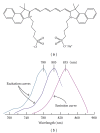Optical imaging in breast cancer diagnosis: the next evolution
- PMID: 23304141
- PMCID: PMC3529498
- DOI: 10.1155/2012/863747
Optical imaging in breast cancer diagnosis: the next evolution
Abstract
Breast cancer is one of the most common cancers among the population of the Western world. Diagnostic methods include mammography, ultrasound, and magnetic resonance; meanwhile, nuclear medicine techniques have a secondary role, being useful in regional assessment and therapy followup. Optical imaging is a very promising imaging technique that uses near-infrared light to assess optical properties of tissues and is expected to play an important role in breast cancer detection. Optical breast imaging can be performed by intrinsic breast tissue contrast alone (hemoglobin, water, and lipid content) or with the use of exogenous fluorescent probes that target specific molecules for breast cancer. Major advantages of optical imaging are that it does not use any radioactive components, very high sensitivity, relatively inexpensive, easily accessible, and the potential to be combined in a multimodal approach with other technologies such as mammography, ultrasound, MRI, and positron emission tomography. Moreover, optical imaging agents could, potentially, be used as "theranostics," combining the process of diagnosis and therapy.
Figures




Similar articles
-
Assessing the future of diffuse optical imaging technologies for breast cancer management.Med Phys. 2008 Jun;35(6):2443-51. doi: 10.1118/1.2919078. Med Phys. 2008. PMID: 18649477 Free PMC article.
-
Supplemental Screening for Breast Cancer in Women With Dense Breasts: A Systematic Review for the U.S. Preventive Service Task Force [Internet].Rockville (MD): Agency for Healthcare Research and Quality (US); 2016 Jan. Report No.: 14-05201-EF-3. Rockville (MD): Agency for Healthcare Research and Quality (US); 2016 Jan. Report No.: 14-05201-EF-3. PMID: 26866210 Free Books & Documents. Review.
-
Positron Emission Tomography/Magnetic Resonance Imaging for Local Tumor Staging in Patients With Primary Breast Cancer: A Comparison With Positron Emission Tomography/Computed Tomography and Magnetic Resonance Imaging.Invest Radiol. 2015 Aug;50(8):505-13. doi: 10.1097/RLI.0000000000000197. Invest Radiol. 2015. PMID: 26115367
-
Optical imaging of the breast.Cancer Imaging. 2008 Nov 25;8(1):206-15. doi: 10.1102/1470-7330.2008.0032. Cancer Imaging. 2008. PMID: 19028613 Free PMC article.
-
Near-infrared optical mammography for breast cancer detection with intrinsic contrast.Ann Biomed Eng. 2012 Feb;40(2):398-407. doi: 10.1007/s10439-011-0404-4. Epub 2011 Oct 5. Ann Biomed Eng. 2012. PMID: 21971964 Free PMC article. Review.
Cited by
-
Recent advances in nanotheranostics for triple negative breast cancer treatment.J Exp Clin Cancer Res. 2019 Oct 28;38(1):430. doi: 10.1186/s13046-019-1443-1. J Exp Clin Cancer Res. 2019. PMID: 31661003 Free PMC article. Review.
-
Indocyanine Green-Conjugated Superparamagnetic Iron Oxide Nanoworm for Multimodality Breast Cancer Imaging.ACS Appl Nano Mater. 2022 Dec 23;5(12):18912-18920. doi: 10.1021/acsanm.2c04687. Epub 2022 Dec 5. ACS Appl Nano Mater. 2022. PMID: 37635916 Free PMC article.
-
Site-selective installation of BASHY fluorescent dyes to Annexin V for targeted detection of apoptotic cells.Chem Commun (Camb). 2016 Dec 22;53(2):368-371. doi: 10.1039/c6cc08671c. Chem Commun (Camb). 2016. PMID: 27935613 Free PMC article.
-
Evaluation of neurotensin receptor 1 as a potential imaging target in pancreatic ductal adenocarcinoma.Amino Acids. 2017 Aug;49(8):1325-1335. doi: 10.1007/s00726-017-2430-5. Epub 2017 May 23. Amino Acids. 2017. PMID: 28536844 Free PMC article.
-
A review on core-shell structured unimolecular nanoparticles for biomedical applications.Adv Drug Deliv Rev. 2018 May;130:58-72. doi: 10.1016/j.addr.2018.07.008. Epub 2018 Jul 20. Adv Drug Deliv Rev. 2018. PMID: 30009887 Free PMC article. Review.
References
-
- Garcia M, Jemal A, Ward EM, et al. Global Cancer Facts & Figures 2007. Atlanta, Ga, USA: American Cancer Society; 2007.
-
- American cancer Society. Statistics for 2004: Cancer facts & figures, 2004, http://www.cancer.org/research/cancerfactsfigures/cancerfactsfigures/index.
-
- Feig SA. Decreased breast cancer mortality through mammographic screening: results of clinical trials. Radiology. 1988;167(3):659–665. - PubMed
-
- Breast cancer. Early detection and prompt treatment are critical. Mayo Clinic Health Letter. 2001;(supplement 1–8) - PubMed
-
- Jacques SL. Time resolved propagation of ultrashort laser pulses within turbid tissues. Applied Optics. 1989;28(12):2223–2229. - PubMed
LinkOut - more resources
Full Text Sources
Other Literature Sources

